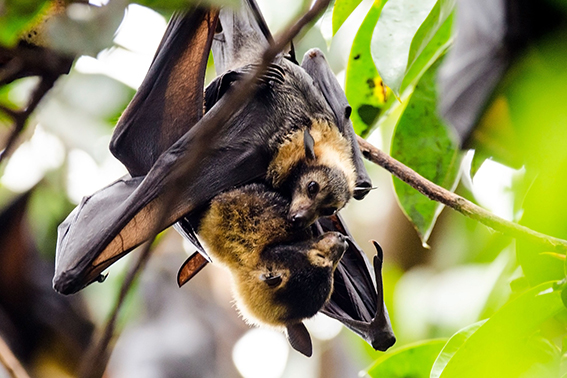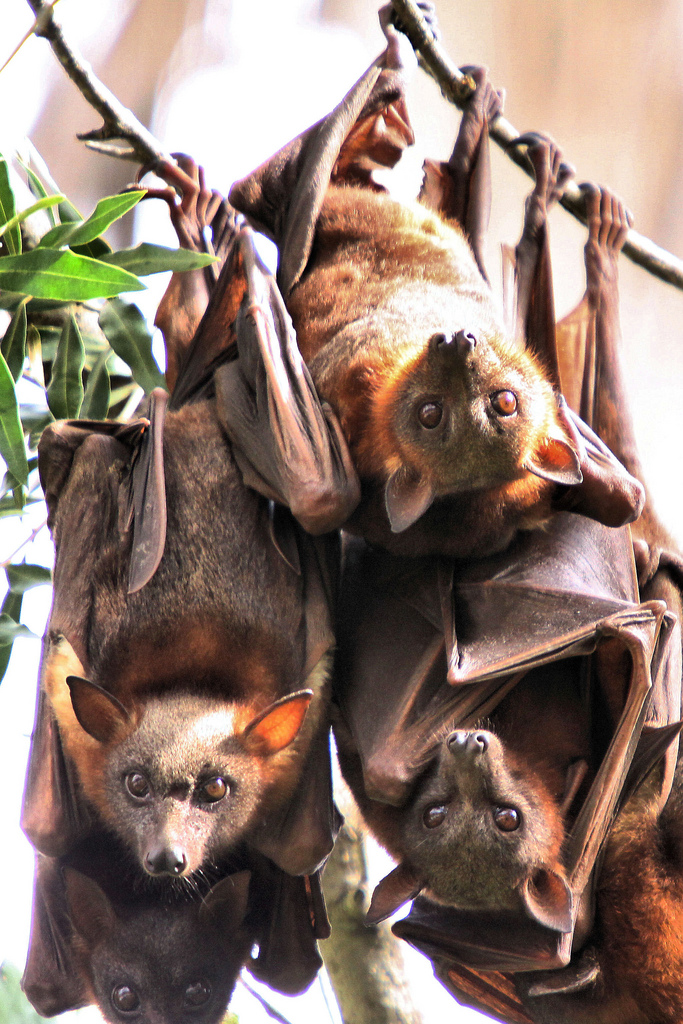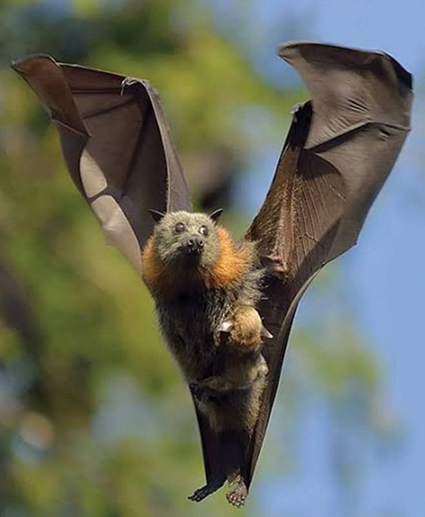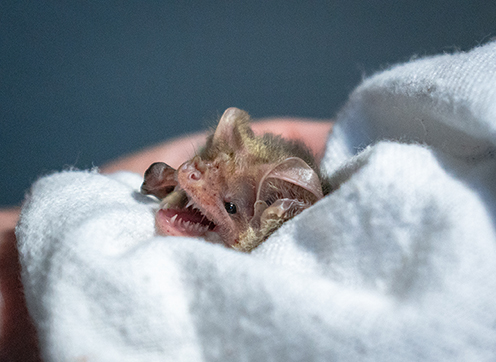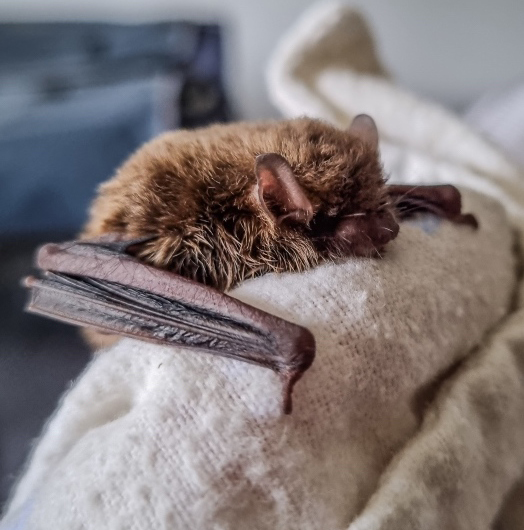Flying-foxes and Microbats
Bats are categorised into Megabats and Microbats. Australian megabats are commonly known as flying-foxes.
Megabats
Megabats are described as a ‘keystone’ species as they play a very important part in pollination for some native trees and shrubs. For some species they are far more efficient than birds and bees, being able to spread pollen and seeds as far as 120 km in one night.
Two species of flying-foxes are found in the ACT: the Grey-headed Flying-fox and the Little Red Flying-fox.
Since large numbers were first recorded in 2003 the Grey-headed flying-fox have been coming to the ACT each year and roosting in Commonwealth Park over the summer season.
They are found up and down the eastern seaboard, from Bundaberg in Queensland to Melbourne in Victoria, and in 2010 began settling in Adelaide. Flying foxes are nomadic, travelling to different locations depending on where food can be found.
They arrive in September/October each year establishing a maternity colony in Commonwealth Park and in most years leave around mid-May. Numbers in the camp in recent years have ranged from 6,000 to more than 9,000.
Little Red flying-foxes are occasional visitors to Canberra and sometimes roost near Lake Ginninderra.
Flying foxes are social animals. They like to live together in camps, high up in trees, safe from predators. Colonies or roosts are other names for camps. They prefer dense vegetation near water.
The Grey-headed flying-fox is listed as vulnerable. Their numbers have been affected by loss of habitat, extreme weather events due to climate change, and human made hazards like fruit netting, barbed wire and electric wires.
Heat stress events can occur when temperatures rise to 40 degrees C or higher. Bats can suffer dehydration, vital organ failure and eventual death. Cold snaps, if temperatures drop below freezing, can cause deaths for young pups who have not yet begun to regulate their own temperature. Hailstorms are another hazard, causing wing damage and broken bones.
Flying foxes:
- Live on a diet of blossom, nectar and fruit
- Can be up to 1kg in weight with a wingspan of up to 2 metres
- Have well developed eyes and a strong sense of smell
- Do not echolocate, unlike most insect eating microbats
- Are sometimes called ‘fruit bats’
- Can fly up to 120 km a night, although more frequently around 30-50km
- They can live to approximately 20 years, but due to extreme weather events and food shortages 8 years is a more normal lifespan in the wild.
In 2024 the ACT Government released a native species conservation plan for the Grey-headed Flying fox, available online at environment.act.gov.au
Interesting facts about Grey-headed Flying-foxes
- Grey headed flying-foxes are a one of the world largest bats.
- The largest number recorded in the Commonwealth Park camp was just over 9000, in the summer of 2019‑20.
- They have established camps near Dubbo, Tamworth, Cowra, Wagga, and Ballarat as well as Brisbane, Sydney, Canberra, Adelaide and Melbourne.
- Some tracked individuals have been found to travel more than over 500 kms in 48 hours, whilst others live in a single camp for a number of years.
- They are warm blooded and deliver a furred open-eyed baby and suckle their young
- The baby has oversized feet and a hook on the thumb hook to aid in clinging to its mother
- The baby is carried very securely for the first five weeks of its life, flying out with its mother at night. Baby bats cannot fly until around 12 weeks old.
- Bat mothers are meticulous in hygiene and use their tongue to lick and groom the baby.
- Flying foxes don’t actually eat fruit, they crush it using their teeth and press it between their tongue and roof of their mouth, suck the juice and spit out the pulp.
- To go to the toilet flying foxes turn themselves upside down (invert) and hang bottom down by their thumbs to do their business, give a shake and then return to hanging by their feet.
- Unlike most bats, grey headed flying foxes have fur all the way down their legs (trousers!).
Less than 1% carry a deadly virus called Australian Bat Lyssavirus. If bitten, seek medical help immediately. To avoid being bitten, DO NOT attempt to rescue a bat, call ACT Wildlife who will send a vaccinated and trained bat rescuer.
ACT Wildlife 0432 300 033
Grey-headed Flying Fox
Little Red Flying Fox
Microbats
In ACT and surrounding areas there are 18 species of bats.
Microbats vary in size but the most common bats in our region are the Chocolate Wattled Bat (adult 12g), Goulds Wattled Bat (adult up to 19g) and the Lesser Long Eared Bat (adult from around 8g to 14.5g). Occasionally other species are recorded.
Identification can be difficult but improves with experience, for instance a Chocolate Wattled bat is an all over brown; a Goulds Wattled Bat has a darker blackish head and a brown or grey-brown body (two-toned) and Lesser Long Eared Bats have large ears.
Microbats:
- Are insectivorous
- Use echolocation to find energy-rich food: moths, flying and terrestrial insects, spiders, beetles, flying termites and mosquitos. Some species have specialized diets and eat fish (myotis), orb spiders (phoeniscus). It is possible that some of the larger microbats may eat smaller bats if housed together (scotorepens orion).
- They eat up to 50% of their weight each night.
- Microbats can catch up to 500 insects in an hour.
- Some species of Microbats can fly at 60kg/hr and fly up to 30km to find food each night.
- Wingspan is approximately 25cm (depending on species).
- Weight of adults approx. 2 – 170g (depending on species).
- Make up the vast majority of Australian bats.
- Have long lifespans compared to other small animals, over 20 years for most species
- Microbats roost in caves, tree bark and hollows, and any small spaces they find including inside cavities in walls and chimneys.
- Microbats make up 20% of the world’s total mammal groups.
- Bats choose roost sites to conserve energy and in cooler climates they go into torpor or even hibernation and will aestivate (torpor) on very hot days.
- Microbats become torpid to conserve energy when at rest.
- The young are born furless with eyes closed (they are called pups), the pup is usually 10% of its mother’s weight.
- There is a membrane between the back legs that houses the tail.
- Both Micro and Megabats may carry different strains of Australian Bat Lyssavirus.
All bats can carry the potentially deadly Lyssavirus. DO NOT try to pick up or rescue any kind of bat. They should only be handled by vaccinated and experienced bat carers. If you see a bat needing help, please call ACT Wildlife on 0432 300 033. We are on call 24/7.
Find out how you can become a bat carer

